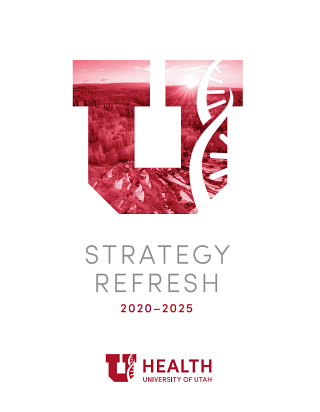
Research Strategy Action Plans
National Distinction

Description
National distinction of University of Utah Health’s research enterprise is critically important for faculty and trainee recruitment and engagement, competitiveness for federal and foundation funding, and philanthropic fundraising. As a leading academic medical center, we have the opportunity and obligation to produce transformative advances that change the way medicine is practiced.
Leads
Prioritized Goals
- Optimize Faculty Recruitment
- Optimize Faculty Mentoring
- Increase individual faculty national recognition and celebrate scientific achievements.
Research Across the Translational Spectrum
Description
Our robust research enterprise portfolio requires monitoring, balancing, and strategic planning to ensure that we are pursuing the optimal range of activities. It is therefore critical that we continually evaluate and, as appropriate, rebalance our research efforts to optimize the ratios of early/mid/senior investigators, wet/dry research, basic/clinical, T0-T5, federal/other funding, career/independent/programmatic funding, etc.
Leads
Prioritized Goals
- Proactively retain highly successful research faculty.
- Ensure succession planning for research programs, centers of excellence, training grant directors, and research leadership positions.
- Promote scientific excellence and innovation as core values.
- Create an integrated infrastructure for translational/clinical research.

Partnerships and Multi-Disciplinary Research

Description
We are fortunate that our U of U Health Sciences Center has an affiliated University Hospital, and is embedded within a major public research university that includes an NCI-designated Comprehensive Cancer Center. As research becomes ever more interdisciplinary, we must continue to create strong partnerships across our different University programs, departments and colleges, and with other local and national health systems. Such partnerships create unique opportunities for individual investigators to have maximum impact, and also increase our ability to compete for major program-level grants that can support transformative research on major challenges that face our world.
Leads
Heather T. Keenan, MD, PHD, MPH
Prioritized Goals
- Integrate research with U of U Health clinical practice by expanding intra-campus partnerships and collaborations.
- Work with other health systems locally and nationally to identify the best possible research collaboration opportunities and proceed where mutual agreement can be reached.
- Strengthen relationships with key stakeholders and collaborators to optimize the conduct and impact of late translational research.
Innovation and Commercialization
Description
IP generation and technology commercialization are important innovation milestones, embody impactful translational research, and lead to the production of new therapeutics, diagnostics, devices, and software that improves human health and spurs economic growth in Utah. It is therefore critical that we continue to support strong research discovery, IP protection, licensing, entrepreneurship, and commercialization efforts so academic discoveries are brought to market, startup companies create new jobs and economic growth for the state and nation, and Utah is established as a leader in life sciences.
Lead
Prioritized Goals
- Enhance our culture of innovation, entrepreneurship, and commercialization and the policies that guide these activities.
- Continue our strong efforts for commercialization.
- Promote programs that train future entrepreneurs.
- Engage and partner with stakeholders including campus groups, PIVOT, policy makers, industry leaders and donors to elevate the value of HS innovations and discoveries.

Public Outreach & Communication
-2.jpg)
Description
Robust research communication provides an opportunity to create common understanding of current research, its relevance within the University, to Utah and its strong biomedical and technology sectors, and society in general. Research communication in combination with education and clinical service missions support the University overall and its unique position in Utah and the Intermountain West. Expanded efforts must be made toward pockets of excellence (e.g., the Genetic Science Learning Center), base research communications, and leveraging the success of public health outreach (e.g., the Wellness Bus) to raise awareness for allied research efforts.
Leads
Julie Kiefer, PhD
Prioritized Goals
- Develop existing communication platforms and mediums for areas of opportunity and establish new platforms as appropriate.
- Build connectivity to our primary audiences.
- Develop impactful content that can be presented on platforms and shared with our various stakeholders/audiences.
Research Space and Infrastructure
Description
High quality space increases research output by providing necessary capacity, fostering creativity, and promoting interactions between researchers with complementary expertise. At present, space limitations represent the single greatest impediment for increasing research productivity at U of U Health. Challenges include a simple lack of available research space, proper programmatic co-localization, and balancing the distribution of on and off campus research sites. Simply put, we have an urgent need for at least one new research building if we are to meet our goals for HSC extramural growth.
Leads
Prioritized Goals
- Build a major new wet-lab research building.
- Revision of wet-lab metrics and establishment and implementation of dry-lab metrics.
- Establish research space gap plan for the critical period between when health sciences research space is exhausted to when a new research building opens.
- Establish health sciences vivaria master plan, eventual CMC replacement. Establish new leadership and guidance on space.
- Create and implement strategies for maintaining cutting-edge instrumentation or resources (e.g., databases) and services for each of the existing core facilities. Add new service lines and create new cores as technological advances and faculty needs dictate.
- Create and implement strategies for increasing awareness of all HSC Cores and the services they provide.
- Enhance employee development and training for improved retention and grant funding success.
- Develop a strategic plan for Cores.

Research Education and Training

Description
U of U Health will provide outstanding research training that is multidisciplinary and innovative and that prepares our diverse cadre of predoctoral and postdoctoral trainees to become successful scientists in a rapidly evolving and complex research enterprise. Robust curricula cover the basic, disease-related, clinical and/or translational disciplines and provide the foundation for research experiences. Along with novel programmatic activities, strong mentoring and oversight, our programs facilitate development toward independent research careers by ensuring that trainees acquire the operational and professional skills to advance knowledge and improve health for all the citizens we serve.
Leads
Prioritized Goals
- Maximize external training support for PhD trainees, MD- PhD trainees, and postdocs.
-
Develop systems to support appropriate growth and excellence of graduate programs.
-
Train the next generation of clinician scientists.
-
Increase the success of graduate students.
-
Strengthen postdoctoral support and mentoring.
-
Create a standard of mentoring.
Career Development
Description
Recognized as an institution that values faculty as its greatest asset, U of U Health will provide a learning environment in which its research faculty can be nurtured to continually grow by gaining new technical, operational and professional skills that enhance career advancement, leadership roles and improve retention. Faculty development programs are responsive to the needs of faculty at early, mid, senior and leadership stages of development and ensures that mentoring through transition phases within the spectrum of grant opportunities is effective in helping each faculty reach his/her unique potential.
Leads
Prioritized Goals
- Improve quantity, quality and consistency of mentorship for early, mid-career and senior faculty, considering differing needs for career and scientific mentorship, and specific mentoring strategies for faculty.
-
Proactively retain highly successful research faculty.
-
Train the next generation of clinician scientists.

Belonging

Description
We are deeply committed to ensuring a welcoming and supportive environment for all individuals. It is well established that groups with varied perspectives make better decisions, a lack of role models can discourage participation, and failing to provide a supportive environment diminishes potential well-being.
Prioritized Goals
-
Foster a culture in which everyone is valued and are continually advanced.
-
Promote scholarship on health disparities.
-
Optimize recruitment and enhance retention and success of trainees, staff, and faculty.
Financial Strength and Sustainability
Description
Sustainability and competitive advantage depend upon maximizing the funds available for research, both externally through grants, philanthropy, State, VA, etc., and internally through maintenance of financial models that support investments in research and promote research excellence. Sustainability will also require strong partnership with the hospitals, including appropriate funds flow and recognition that research distinction enhances clinical competitive advantage; issues that are discussed in the report on multidisciplinary research and partnership. Some most important objectives identified in this section relate to faculty, department, and initiative support and expectations – which have been merged with related objectives from other sections and presented as a consolidated section.
Leads
Prioritized Goals
- Optimize support for departments, programs and initiatives.
- Maximize research support from philanthropy and the State (and Federal) government.
- Strategic review of investments.
- Optimize the size and impact of research investment.

Contact Us
Please share your feedback and ideas.


